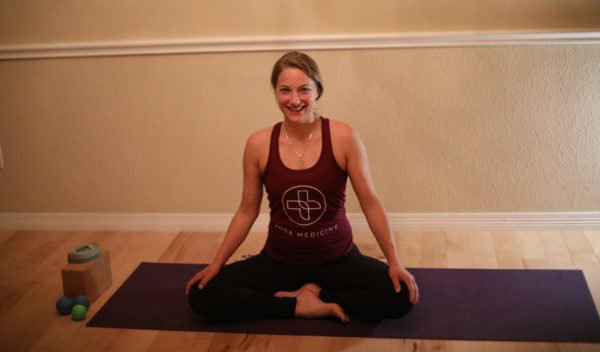Allie Geer, Articles, Chinese Medicine, Myofascial Release, Yin, Restorative and Meditation, Yoga Medicine® News
Yoga & Chinese Medicine: Unwinding the Back Line
Allie Geer, Yoga Medicine Instructor shares a yoga practice that is perfect for winter. Learn about the Chinese Medicine concept of the Back Line, and how to use it to find balance, and treat tightness and pain.
A Nourishing Practice for the Winter
“My hamstrings are tight.” “My low back hurts.” “My feet are sore.” These are such commonly heard phrases both in and out of a yoga studio. Up until recently, I addressed these issues by picking different poses that I felt might be able to provide some relief. Great, right? But as a yoga teacher maybe it’s even more important to look at the interconnectedness of the whole body, using the big picture to create balance. When we look at the fascial connections in the body, we can clearly see that it’s all interrelated. What’s also compelling to me as a teacher is a connection to our health through nature and our energetic body with Traditional Chinese Medicine.
The Superficial Back Line
The Superficial Back Line is a continuous line of connective tissue extending from the bottom of the foot up the back side of the body over the top of the head. Tension, movement patterns, trauma, or strain here tends to transmit throughout this fascial line. In our body, this line has both a left and a right side. In Yoga Medicine’s recent cadaver dissection, I had the honor of meticulously dissecting this superficial back line. This process gave me a hands-on experience of just how interconnected these tissues are and helped me to see in person why so many of us (myself included) struggle with pain, weakness, or resistance here. I believe the answer tends to lie within our own fascial restrictions.
The muscles involved in this line are some of the most common culprits for back, leg and foot pain. Rather than thinking of them or working with them as separate entities, it’s important to work with them as a team.
Landmarks of the Superficial Back Line
- Plantar fascia of the foot
- Gastrocnemius
- Hamstrings
- Sacral Tuberous Ligament
- Erector Spinae
- Epicranial Fascia
Connection to Traditional Chinese Medicine
What I find most interesting about the superficial back line is the connection to the bladder meridian in Chinese Medicine theory. In fact, their pathways are almost identical. In Chinese Medicine theory, the bladder meridian is part of the water element which is associated seasonally with winter. Winter represents the most Yin aspect in Chinese Medicine. Qualities of yin are slow, dark, cold, an inward energy compared to those of yang which are fast, bright, hot, an outward energy. Winter is an important time to nourish the yin qualities through introspective practices to harmonize and balance the body, and its relationship to nature.
The following practice focuses on the connection between the superficial back line and the kidney and bladder meridians. May this practice nourish your body and mind from the inside out and help you to settle into to the winter months. Enjoy!
Practice to Cultivate Balance through the Back Line
Myofascial Releases:
1. Begin standing with a tennis ball or myofascial release ball near a wall for balance. Roll out one foot at a time, working the arches, ball of the foot and even into the heal. 30-60 seconds. Pause between sides in a brief forward fold to notice the difference. Repeat the second side.
2. Seated, using tennis balls or myofascial release balls, one leg at time roll the calves (using a block under the calf for support), then roll the hamstrings, switch sides.


3. Roll the erectors, using your myofascial release balls or tennis balls. Sometimes it’s helpful to put 2 balls into a sock (use the wall as a gentler modification).
4. Roll back of the neck with a block on the medium height. The closer edge of the block should sit at the base of the skull so the neck is off of the block.
Breath Exercises
1. Lying on our backs with feet into the mat about hip-width take a moment to observe sensations in the body. Begin to connect with the breath.
2. Adding belly breath, begin to contract the transverse abdominals (TVA). On the exhale, draw in around the spine, cinching around the waistline as if you were putting on a belt. Notice the connection we have from the front body to the back body through our diaphragm and abdominal wall.
Yoga Poses
1. From all fours take some variations on cat/cow.


2. Bird Dog (lifting alternate arms and legs in tabletop) paying attention to the connection around the waist and through the back side of the body.
3. Salabhasana noticing the awakening of the back line from heels to head. Draw in around the belly to support the spine.
4. Crescent Lunge to Warrior 3 variation, moving slowly and mindfully.


4. Seated, perform a forward fold of choice (Paschimottasana, Janu Sirsasana, Upavista Konasana) adding any props to support the body in a longer hold. Let the focus and intention be on the breath. Create stillness in the body to tune in and listen.
5. Lying on back Supported Bridge with either a block or bolster under the hips/sacrum.
6. Supta Padangusthasana with a strap, hold each side for 2-3 minutes with a pause between sides.
14. Set up Savasana in the Divine Heart Opener. Accordion fold a blanket( about 2 inches in width) so that it rests down the length of your spine. Let the hips be free on the mat or can rest on a folded square blanket for support. A bolster under the knees might feel nice if there is any lower back pain.













